外研版英语必修四 Module 3 Body language and Non-verbal Communication Introduction Reading and Vocabulary 课
文档属性
| 名称 | 外研版英语必修四 Module 3 Body language and Non-verbal Communication Introduction Reading and Vocabulary 课 | 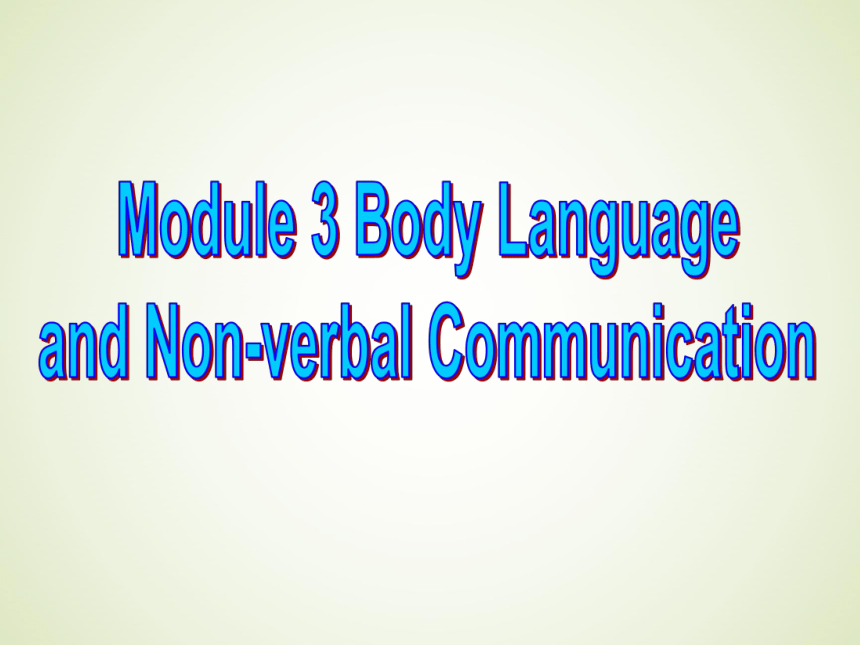 | |
| 格式 | zip | ||
| 文件大小 | 5.9MB | ||
| 资源类型 | 教案 | ||
| 版本资源 | 外研版 | ||
| 科目 | 英语 | ||
| 更新时间 | 2019-05-07 22:06:12 | ||
图片预览


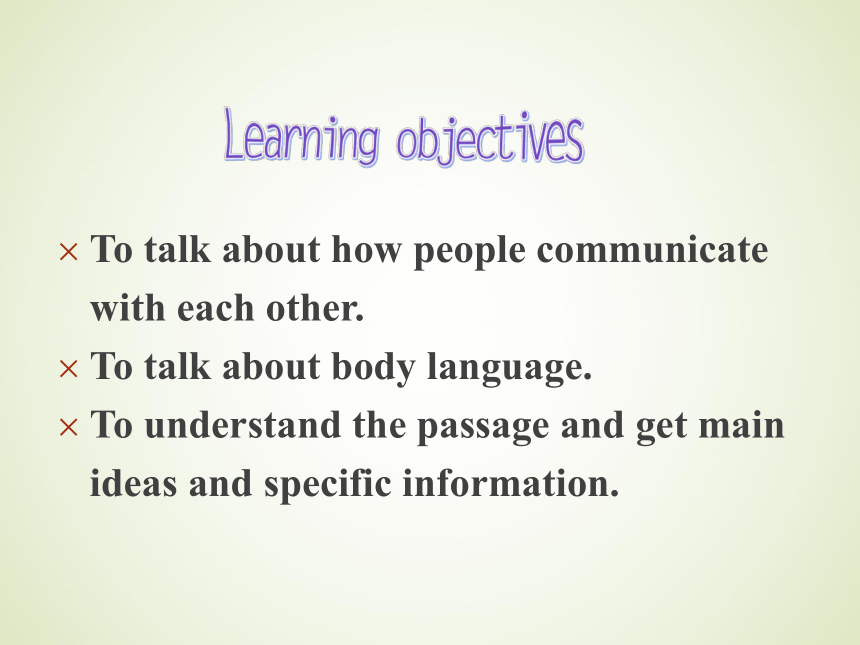
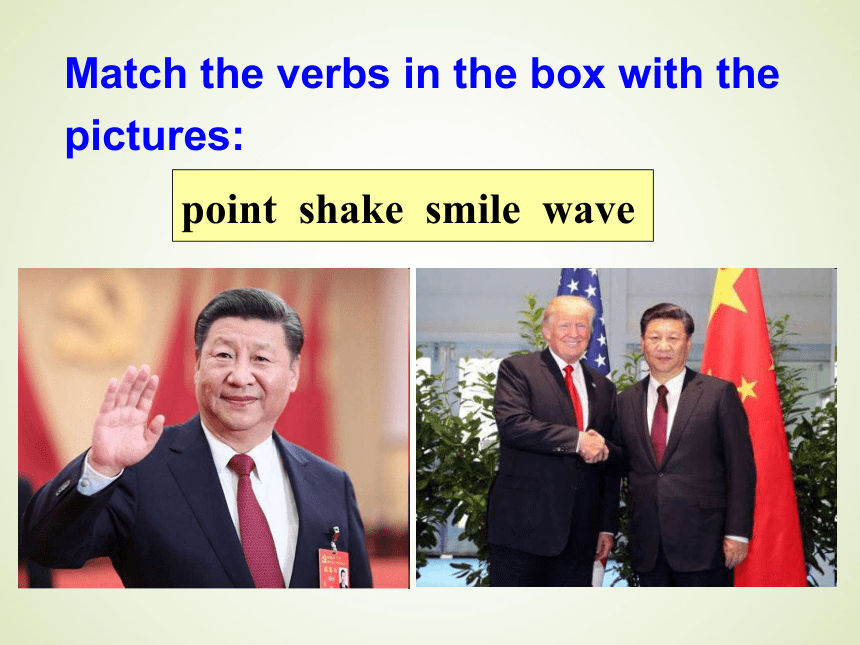

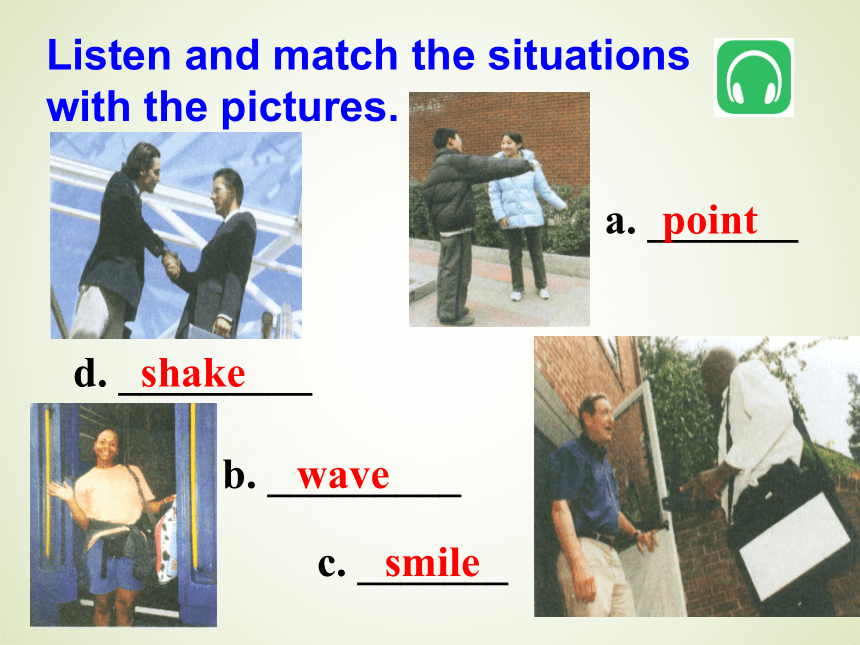
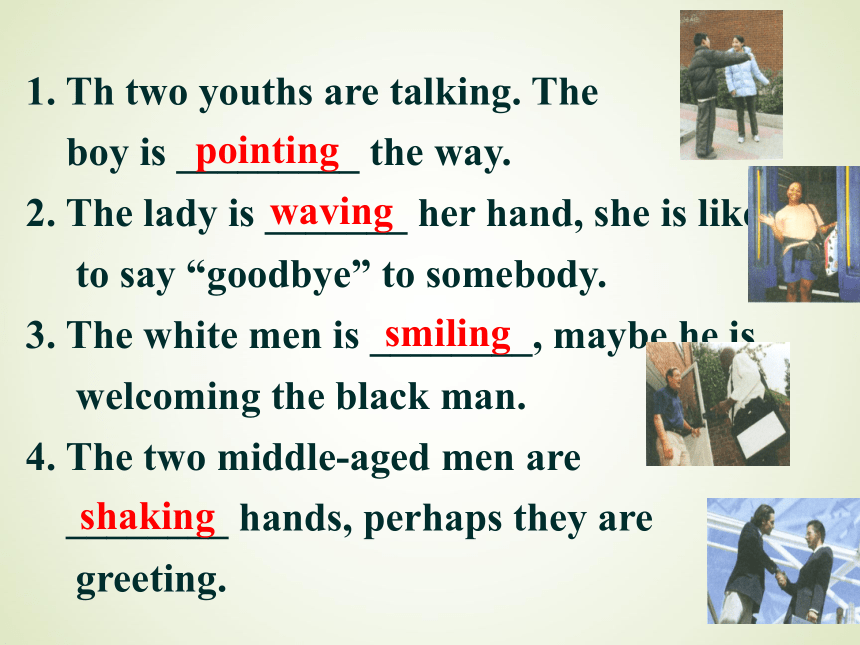
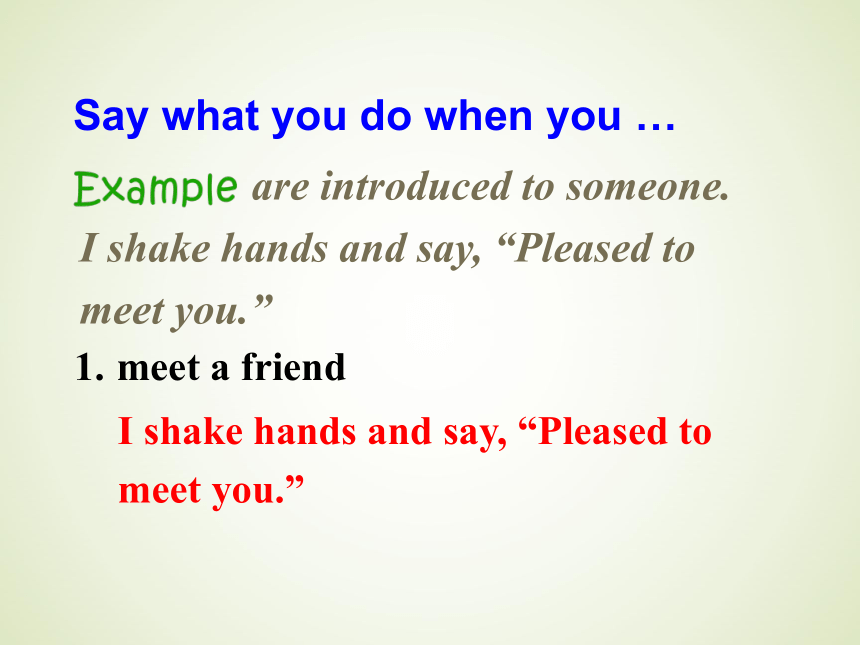
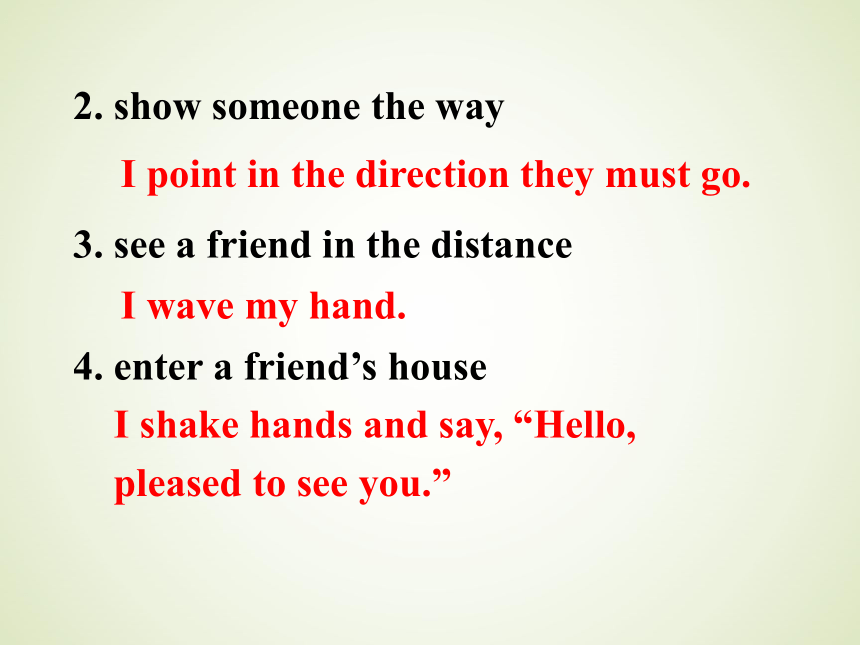
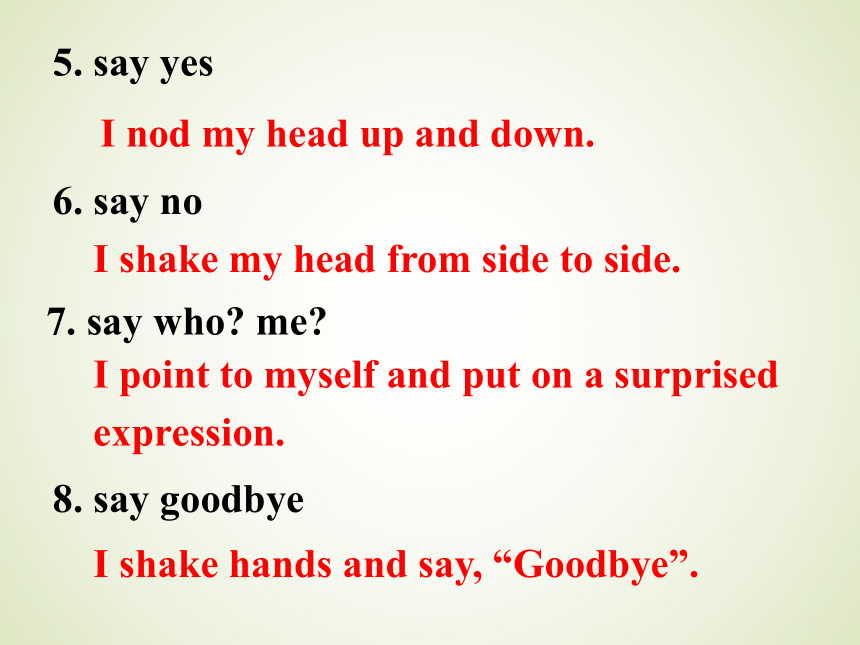
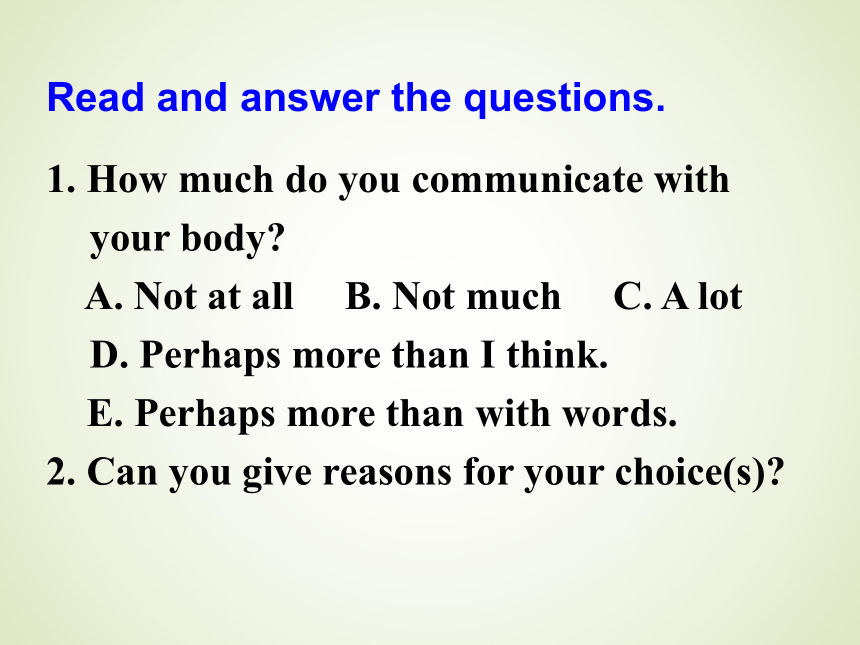

文档简介
课件47张PPT。Module 3 Body Language
and Non-verbal CommunicationTo talk about how people communicate with each other.
To talk about body language.
To understand the passage and get main ideas and specific information.
Match the verbs in the box with the pictures:point shake smile wave wave smile point shakeListen and match the situations with the pictures.c. _______d. _________ b. _________wavesmileshakea. _______point1. Th two youths are talking. The
boy is _________ the way.
2. The lady is _______ her hand, she is likely to say “goodbye” to somebody.
3. The white men is ________, maybe he is welcoming the black man.
4. The two middle-aged men are
________ hands, perhaps they are greeting.pointingwavingsmilingshaking are introduced to someone.
I shake hands and say, “Pleased to meet you.” meet a friendI shake hands and say, “Pleased to meet you.”Say what you do when you …2. show someone the wayI point in the direction they must go. I wave my hand.I shake hands and say, “Hello, pleased to see you.”4. enter a friend’s house3. see a friend in the distance5. say yes I nod my head up and down.I shake my head from side to side. I point to myself and put on a surprised expression. I shake hands and say, “Goodbye”. 8. say goodbye7. say who? me?6. say no 1. How much do you communicate with your body?
A.?Not at all B. Not much C. A lot D. Perhaps more than I think.
E. Perhaps more than with words.
2.?Can you give reasons for your choice(s)? Read and answer the questions. Hand GesturequietOKwell doneI love youvictoryBad/
look down upon sb.stopclapprayspeakingringingwritingtypingSpoken
languageWritten
languageBody
languageWays of communicatinggesturefacial expressionactionWhat is body language?Body language is one form of nonverbal communication (非言辞交际) without using words. Eye contact or gaze, facial expression, gesture, and posture (姿势), or the way you stand, are different kinds of body language.Some psychologists believe that we communicate 65% of our ideas and feelings without words! The shape of our bodies and faces, the movements and gestures we make, the clothes we wear, how near we stand to each other and whether we touch each other … all these communicate. 1. Think of some ways to greet people in China.
2. What body language do people usually use in China?
3. Say some different body languages in China and western countries.Look at the following pictures and guess what we will learn in the lesson.Body language1 Saying It Without Words
2 When in Rome, Do as the Romans
Do 入乡随俗
3 Greetings Around the World
4 Read My MindListen and skim the text and choose the best title.Match column A with column B.Examples
of greetingsPara 1Para 2Para 3Para 4Para 5ABgreetings in Asian countriesways of communicationfascinating body languageBody language is fascinating
for us to study.American youth’s greeting
todayA
Europeans and Americans
2. American youths
3. Chinese
4. Muslims
5. HindusB
a. touching their heart,
mouth and forehead
b. shaking hands with
their right hands
c. joining their hands and
bowing their heads in
respect
d. Putting the right hand over
the left and bowing slightly
e. Greeting each other with
the expression, “Give me
five!” Scan the text and match.Fill in the blanks in the chart, trying to understand the key information of the text.communicationwords and 1. ___________body
language2. ___________ body language
“learned” body languagehelp to read
people's
5. ______sentencesunconsciousbowingGive me five! mindsRead the text carefully
and finish the following tasks.(1) Not all body language is conscious.
( )
(2) Europeans shake hands with their
left hand. ( )
(3) In Asia, people touch strangers when
they meet. ( ) FFTDecide whether the statements are true (T) or false (F). (4) In the US a “high five” is a way of saying hello. ( )
(5) A “high five” is a formal gesture. ( )
(6) Body language is less communicative than spoken or written language. ( )FTFFill in the blanks.written Europeansthreatening weapon?Give me fiveslaps? foreheadhandsgesturesMatch “what we want to express”
with “what we do”.1-B 2-C 3-AComplete the chart showing all kinds of gestures from the text.gesturesput the right hand over the left1. ______ slightlygive a “salaam”
—— touch their 2. ________,
mouth and forehead4. ________ the other's open hand above the headraise his handhold up the hand, 3. ______ outwards and five fingers spreadbow their headsshake handsjoin their handsbowheartpalmslapDo you think it is important to know about non-verbal communication in different cultures? Why do you think that way?We communicate with 1._________ just
spoken and written words. We also need to
learn body language, which 2.________ from
culture to culture. Traditionally, Europeans
and Americans shake hands with their right
hand. It means “I trust you. Look, I am not
carrying a 3.____________ weapon.” They
also shake hands when they make a
4.________. more thanvariesthreateningdealIn China, we put the right hand over the left
and bow 5.________ when we greet someone
while Muslims give a “salaam”. Hindus join
their hands and bow their heads in respect.
The expression “Give me five!” is also a
gesture for American youths to greet one
another. Body language is 6.__________ for
anyone to study. You can give 7.________ much
more by gestures than by words. So look at
your friends and family to see if you are a
8._______________.slightlyfascinatingawaymind reader1. Role play. Imagine you are Americans
and Asians respectively. Act the ways
people greet each other according to
the text.2. Greetings vary from culture to culture.
Summarize the greetings in different
countries according to the passage.
and Non-verbal CommunicationTo talk about how people communicate with each other.
To talk about body language.
To understand the passage and get main ideas and specific information.
Match the verbs in the box with the pictures:point shake smile wave wave smile point shakeListen and match the situations with the pictures.c. _______d. _________ b. _________wavesmileshakea. _______point1. Th two youths are talking. The
boy is _________ the way.
2. The lady is _______ her hand, she is likely to say “goodbye” to somebody.
3. The white men is ________, maybe he is welcoming the black man.
4. The two middle-aged men are
________ hands, perhaps they are greeting.pointingwavingsmilingshaking are introduced to someone.
I shake hands and say, “Pleased to meet you.” meet a friendI shake hands and say, “Pleased to meet you.”Say what you do when you …2. show someone the wayI point in the direction they must go. I wave my hand.I shake hands and say, “Hello, pleased to see you.”4. enter a friend’s house3. see a friend in the distance5. say yes I nod my head up and down.I shake my head from side to side. I point to myself and put on a surprised expression. I shake hands and say, “Goodbye”. 8. say goodbye7. say who? me?6. say no 1. How much do you communicate with your body?
A.?Not at all B. Not much C. A lot D. Perhaps more than I think.
E. Perhaps more than with words.
2.?Can you give reasons for your choice(s)? Read and answer the questions. Hand GesturequietOKwell doneI love youvictoryBad/
look down upon sb.stopclapprayspeakingringingwritingtypingSpoken
languageWritten
languageBody
languageWays of communicatinggesturefacial expressionactionWhat is body language?Body language is one form of nonverbal communication (非言辞交际) without using words. Eye contact or gaze, facial expression, gesture, and posture (姿势), or the way you stand, are different kinds of body language.Some psychologists believe that we communicate 65% of our ideas and feelings without words! The shape of our bodies and faces, the movements and gestures we make, the clothes we wear, how near we stand to each other and whether we touch each other … all these communicate. 1. Think of some ways to greet people in China.
2. What body language do people usually use in China?
3. Say some different body languages in China and western countries.Look at the following pictures and guess what we will learn in the lesson.Body language1 Saying It Without Words
2 When in Rome, Do as the Romans
Do 入乡随俗
3 Greetings Around the World
4 Read My MindListen and skim the text and choose the best title.Match column A with column B.Examples
of greetingsPara 1Para 2Para 3Para 4Para 5ABgreetings in Asian countriesways of communicationfascinating body languageBody language is fascinating
for us to study.American youth’s greeting
todayA
Europeans and Americans
2. American youths
3. Chinese
4. Muslims
5. HindusB
a. touching their heart,
mouth and forehead
b. shaking hands with
their right hands
c. joining their hands and
bowing their heads in
respect
d. Putting the right hand over
the left and bowing slightly
e. Greeting each other with
the expression, “Give me
five!” Scan the text and match.Fill in the blanks in the chart, trying to understand the key information of the text.communicationwords and 1. ___________body
language2. ___________ body language
“learned” body languagehelp to read
people's
5. ______sentencesunconsciousbowingGive me five! mindsRead the text carefully
and finish the following tasks.(1) Not all body language is conscious.
( )
(2) Europeans shake hands with their
left hand. ( )
(3) In Asia, people touch strangers when
they meet. ( ) FFTDecide whether the statements are true (T) or false (F). (4) In the US a “high five” is a way of saying hello. ( )
(5) A “high five” is a formal gesture. ( )
(6) Body language is less communicative than spoken or written language. ( )FTFFill in the blanks.written Europeansthreatening weapon?Give me fiveslaps? foreheadhandsgesturesMatch “what we want to express”
with “what we do”.1-B 2-C 3-AComplete the chart showing all kinds of gestures from the text.gesturesput the right hand over the left1. ______ slightlygive a “salaam”
—— touch their 2. ________,
mouth and forehead4. ________ the other's open hand above the headraise his handhold up the hand, 3. ______ outwards and five fingers spreadbow their headsshake handsjoin their handsbowheartpalmslapDo you think it is important to know about non-verbal communication in different cultures? Why do you think that way?We communicate with 1._________ just
spoken and written words. We also need to
learn body language, which 2.________ from
culture to culture. Traditionally, Europeans
and Americans shake hands with their right
hand. It means “I trust you. Look, I am not
carrying a 3.____________ weapon.” They
also shake hands when they make a
4.________. more thanvariesthreateningdealIn China, we put the right hand over the left
and bow 5.________ when we greet someone
while Muslims give a “salaam”. Hindus join
their hands and bow their heads in respect.
The expression “Give me five!” is also a
gesture for American youths to greet one
another. Body language is 6.__________ for
anyone to study. You can give 7.________ much
more by gestures than by words. So look at
your friends and family to see if you are a
8._______________.slightlyfascinatingawaymind reader1. Role play. Imagine you are Americans
and Asians respectively. Act the ways
people greet each other according to
the text.2. Greetings vary from culture to culture.
Summarize the greetings in different
countries according to the passage.
